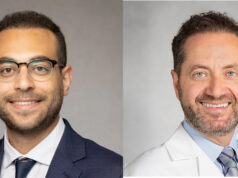
HOUSTON—The picture as Jonathan Stone, MD, describes it couldn’t be more stark. Medical error, according to recent publications, he says, now sits at third place among the leading causes of death. “Right behind heart disease and cancer there is medical error,” explains the assistant professor in the department of neurosurgery at the University of Rochester in Rochester, New York.
Stone was giving a talk on “Surgical simulation utilizing 3D printing” at the inaugural DeBakey CV Congress: Advanced Interventional Cardiovascular Imaging and Robotics in Houston (Feb. 26–27).
It’s a branch of research he entered in conjunction with the department of vascular surgery at his parent institution. Significantly, he has skin in the game as an innovator-owner. Since first developing hydrogel phantoms by exploiting polymer chemistry and 3D printing, he spun out his simulation advances into a company that sells the product. He is both CEO and surgeon.
During his talk, Stone laments the model of surgical training as still essentially taking the form of an apprenticeship. The future, he says, favors simulation. He can’t be sure of the type of platform that will take over surgical education. Perhaps virtual reality, he considers. Or perhaps a more physical model like his 3D printed simulations, in which human organs are sculpted out of hydrogels.
Practice
“We practice every single day and spend our careers getting better and better at what we do,” Stone tells the DeBakey CV Congress. “Unfortunately for patients, that means at some point we’re using them as tools. It was back in 1927 Will Mayo, MD, said, ‘There is no excuse today to practice on patients.’
“Even back then, what he was talking about was visiting other surgeons and observing them rather than trying to do it yourself. Fast forward to today, we still have much of an apprenticeship model of surgical education. The reason is we don’t have a good platform for open surgical education.
“There have been many advances in virtual reality and augmented reality, but there is still nothing that provides the good habits and the ability to build technical skills outside the operating room.”
The imperative is real, Stone says, and “becoming increasingly important because of the awareness around patient safety and quality of healthcare delivery.” Surgeons and healthcare delivery agents like him, he goes on, show that they’re actively attempting to reduce medical errors.
“When it comes to surgeries, there are two classes,” he says. “You have the regular with low surgical error rate. Yes—as you do more you get better. Then you have these complex surgeries where, when you first start, there’s a very high complication rate.”
How are complex surgeries broken down to the regular level? This is where Stone posits a role for 3D simulations, describing the range of technology available. Using regular 3D printers—from as little as $1,000 (or even less), up to $350,000—hydrogel-built models are produced, using the geometry of the organs in order to create realistic representations, he says.
Advances
Stone and his team have come a long way since they started out, he explains. The colors are more realistic. The textures, too. The simulations are multilayered. They’re now putting in engineering in the shape of fine wires so electrical conductivity can be measured. “You can ultrasound them … CT [computerized tomography] them,” he adds.
Stone thens turns to one of the alternatives to his form of simulation. “You see a lot of these virtual reality systems coming out where you’re holding these controls that aren’t real tools,” he says. “I feel like using the real tools is a critical step.”
He touched on vascular applications. “We spend a lot of time on the plaque interface with our carotid models so you can really get down to the details … You can do angiography on them, deploy stents.”
Do the data back up the utility of 3D simulations? “We had a study published looking at attending vs. resident performance,” he explains. “Just looking at these times is very telling. The attendants spent about an hour doing a carotid endarterectomy. That’s pretty good, about what they’d spend on a human.” The resident time, on the other hand, stood at 140 mins. Thus, patients, he muses, might quickly identify which surgeon they want performing their procedure.
New technology
Stone highlighted 3D simulation’s ability to allow for the practice of new and emerging technology.
He draws on an intriguing example. “When we first did TCAR [transcarotid artery revascularization] at our institution about five years ago, before we put it in a human—we put it in one of these models. We did a complete procedural rehearsal, and you were able to run through all the steps, skin-to-skin, and make sure we were comfortable with that procedure.”
He adds, “We really look forward to an opportunity for people to practice rare scenarios or emergent scenarios where the training step is usually pushed aside because it’s a life- threatening situation.”
The next step for 3D surgical simulation lies in patient-specific solutions, Stone goes on, where an individual’s particular anatomical component is recreated by converting DICOM images into stereolithography files and 3D printing components for assembly. That would allow for practice of that patient-specific surgery prior to the actual event.
But the conundrum, admits Stone, is this: Who do you need to rehearse these procedures—and how often— without doubling workload?
“The complex [procedures], the difficult tumors, the complex aortic aneurysms, those are the obvious uses,” he says. “That’s what we’re trying to figure out: The right patient population that necessitates this patient-specific simulation.”
The future, it seems, is already here. For Stone, it’s all about progress. “As we look forward, we use a combination of patient-specific and idealized simulation to train the resident staff and gain new skills with advancing technology.”












